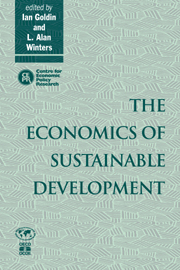Book contents
- Frontmatter
- Contents
- List of figures
- List of tables
- Preface
- Acknowledgements
- List of conference participants
- 1 Economic policies for sustainable development
- PART ONE GROWTH AND THE ENVIRONMENT
- PART TWO SUSTAINABILITY
- PART THREE DOMESTIC POLICY
- PART FOUR INTERNATIONAL POLICY COORDINATION
- 9 Carbon abatement, transfers and energy efficiency
- 10 Policy coordination for sustainability: commitments, transfers, and linked negotiations
- Discussion
- 11 Industrial competitiveness, environmental regulation and direct foreign investment
- Discussion
- Index
Discussion
Published online by Cambridge University Press: 04 August 2010
- Frontmatter
- Contents
- List of figures
- List of tables
- Preface
- Acknowledgements
- List of conference participants
- 1 Economic policies for sustainable development
- PART ONE GROWTH AND THE ENVIRONMENT
- PART TWO SUSTAINABILITY
- PART THREE DOMESTIC POLICY
- PART FOUR INTERNATIONAL POLICY COORDINATION
- 9 Carbon abatement, transfers and energy efficiency
- 10 Policy coordination for sustainability: commitments, transfers, and linked negotiations
- Discussion
- 11 Industrial competitiveness, environmental regulation and direct foreign investment
- Discussion
- Index
Summary
An important issue at the nexus of environmental and trade policies concerns the negative impact that an environment protection policy could have on a nation's welfare, through lessening its competitiveness and consequently the level of its economic activity. Then, in a noncooperative game, all countries will tend to adopt lax environmental policies, for fear of losing industrial competitiveness and employment to other countries. We have here a classic example of suboptimal Nash equilibrium; here, noncooperation among actors leads to excessive pollution. The argument is of course reinforced if one introduces transfrontier pollution, which obviously needs to be taken into account within an international coordination framework.
Kanbur, Keen and van Wijnbergen's chapter 11 (hereafter KKW) provides an elegant illustration of this issue, based on a simple two-country model. Their model assumes that each country maximises a utility function depending positively on income provided by economic activity (profit taxes collected by the government in the KKW framework) and negatively on pollution, which is a result of economic activity itself.
There is nothing new in the result that the Nash equilibrium of the game considered is suboptimal. It is defined as the crossing point of two rising reaction curves, defined in terms of pollutant emission (d and D). These reaction curves result classically from utility maximisation, with isoutility curves, of the home countries represented as in figure D11.1. In such a context, it is clear that the noncooperative Nash equilibrium is suboptimal.
The model presented by KKW has, however, an original feature, because they introduce an asymmetry among the two countries.
- Type
- Chapter
- Information
- The Economics of Sustainable Development , pp. 302 - 306Publisher: Cambridge University PressPrint publication year: 1995



